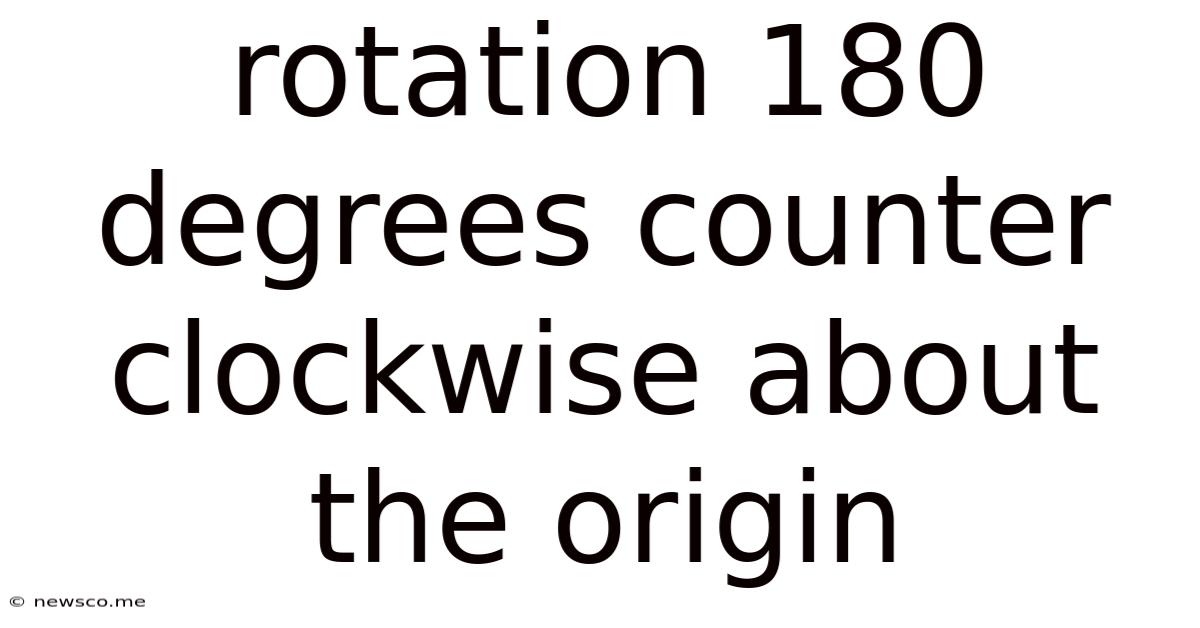Rotation 180 Degrees Counter Clockwise About The Origin
News Co
Apr 27, 2025 · 4 min read

Table of Contents
Rotation of 180 Degrees Counter-Clockwise About the Origin: A Comprehensive Guide
Rotating a point or a shape 180 degrees counter-clockwise about the origin is a fundamental transformation in geometry with wide-ranging applications in mathematics, computer graphics, and physics. This comprehensive guide will explore this transformation in detail, covering its geometric interpretation, algebraic representation using matrices, and practical examples. We'll also delve into related concepts and applications.
Understanding the Geometric Transformation
Imagine a point P(x, y) on a Cartesian coordinate plane. Rotating this point 180 degrees counter-clockwise about the origin (0, 0) essentially flips it across the origin. This means that the new point, P'(x', y'), will be located on the opposite side of the origin, equidistant from the origin as the original point.
Visualizing the Rotation:
Think of a line segment connecting the origin and the point P(x, y). Rotating this segment 180 degrees counter-clockwise will effectively extend the line segment on the opposite side, resulting in the new point P'(x', y'). This creates a straight line passing through the origin.
Key Observations:
-
Sign Change: The most significant observation is that both the x and y coordinates change their signs. If P(x, y) is rotated 180 degrees counter-clockwise, the resulting point P'(x', y') will have coordinates (-x, -y).
-
Distance from Origin: The distance of the point from the origin remains unchanged. This distance is given by the formula: √(x² + y²). This remains consistent before and after the rotation.
-
Symmetry: The rotation exhibits symmetry about the origin. The original point and the rotated point are symmetric with respect to the origin.
Algebraic Representation Using Matrices
Rotation transformations can be efficiently represented using matrices. For a 180-degree counter-clockwise rotation about the origin, the transformation matrix is:
[ -1 0 ]
[ 0 -1 ]
To apply this transformation to a point P(x, y), we represent the point as a column vector:
[ x ]
[ y ]
Multiplying the transformation matrix by the point vector gives the new coordinates:
[ -1 0 ] [ x ] = [ -x ]
[ 0 -1 ] [ y ] [ -y ]
This confirms our earlier observation that the new coordinates are (-x, -y).
Applying the Rotation to Shapes
The same principle applies to rotating entire shapes. To rotate a shape 180 degrees counter-clockwise about the origin, you simply apply the transformation to each of its constituent points. For instance, consider a triangle with vertices A(1, 2), B(3, 1), and C(2, -1).
Original Coordinates:
- A(1, 2)
- B(3, 1)
- C(2, -1)
Rotated Coordinates (180 degrees counter-clockwise):
- A'(-1, -2)
- B'(-3, -1)
- C'(-2, 1)
By plotting these new coordinates, you can see the rotated triangle, which is a mirror image of the original triangle across the origin.
Applications in Computer Graphics
Rotation of 180 degrees counter-clockwise is a crucial transformation in computer graphics. It is used in:
- Game Development: Rotating game objects, characters, and environments.
- Image Manipulation: Creating special effects, reflections, and mirroring images.
- 3D Modeling: Transforming objects in three-dimensional space.
- Animation: Creating smooth transitions and realistic movements.
The matrix representation allows for efficient computation and implementation in computer graphics algorithms.
Applications in Physics
Rotational transformations are fundamental in physics, particularly in areas like:
- Classical Mechanics: Analyzing rotational motion of rigid bodies. The 180-degree rotation can represent a specific orientation change of an object.
- Quantum Mechanics: Representing rotations of quantum states.
- Electromagnetism: Describing the behavior of electric and magnetic fields under rotation.
Extending the Concept: General Rotations
While we have focused on a 180-degree counter-clockwise rotation, the principles extend to rotations of other angles. The general rotation matrix for a counter-clockwise rotation of θ degrees about the origin is:
[ cos(θ) -sin(θ) ]
[ sin(θ) cos(θ) ]
For θ = 180 degrees, cos(180°) = -1 and sin(180°) = 0, which simplifies to our earlier 180-degree rotation matrix.
Practical Exercises and Examples
-
Rotate the point (4, -3) 180 degrees counter-clockwise about the origin.
Using the transformation: (-x, -y), the rotated point is (-4, 3).
-
Rotate a square with vertices (1, 1), (1, -1), (-1, -1), (-1, 1) 180 degrees counter-clockwise about the origin.
Applying the transformation to each vertex will result in a square with vertices (-1, -1), (-1, 1), (1, 1), (1, -1). Notice this is the same square, just rotated 180 degrees.
-
Consider a circle centered at (2, 3) with a radius of 2. Describe the effect of a 180-degree counter-clockwise rotation about the origin.
The center of the circle will be transformed to (-2, -3). The radius and shape of the circle remain unchanged. The circle will simply be rotated 180 degrees around the origin.
Conclusion
Rotating a point or shape 180 degrees counter-clockwise about the origin is a straightforward yet powerful transformation with significant applications across diverse fields. Understanding its geometric interpretation and the algebraic representation through matrices is crucial for anyone working with geometric transformations, whether in mathematics, computer science, or physics. This comprehensive guide has provided the foundational knowledge and practical tools to confidently work with this fundamental concept. The ability to visualize and manipulate these transformations is a key skill in many scientific and technological pursuits. Further exploration into more complex rotations and transformations builds upon this solid base.
Latest Posts
Related Post
Thank you for visiting our website which covers about Rotation 180 Degrees Counter Clockwise About The Origin . We hope the information provided has been useful to you. Feel free to contact us if you have any questions or need further assistance. See you next time and don't miss to bookmark.